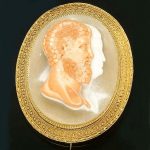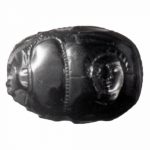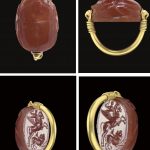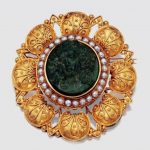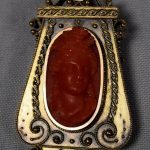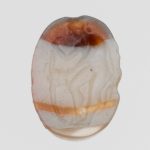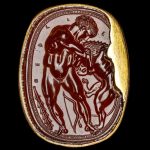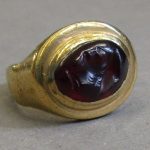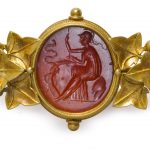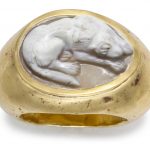Information on Etruscan and Etruscan style cameos and intaglios. The Etruscans inhabited western central Italy. This culture developed out of the Iron Age Villanovan culture—they are traditionally called ‘Etruscan’ after 700 BC, when their language was first written. Etruria was made up of twelve city-states, united by language and religion, who were loosely allied in the Etruscan league. Early on, kings ruled the city-states, but by 500 BC, the power was held by magistrates of the aristocratic class. Ancient Etruria was rich in mineral ores, agricultural resources, and timber; they were a wealthy people. The Etruscans were greatly influenced by the contemporary Greeks but they had their own distinctive character, which in turn influenced the neighbouring Italian peoples, including the Romans. The Etruscans reached the height of their civilization during the sixth century BC. Their decline was caused by the assault on them by the Greeks, the Gauls, and the Romans. They fought with Rome until circa 280 BC, by which time all the Etruscan city sates had lost their independence. By the first century BC, the Etruscans were assimilated into the Roman world. Used with Italy as Production place. Reference: The British Museum
The Etruscan Revival era emerged at the height of the Victorian period following the discovery of jewelry from this ancient Italian civilization in tombs outside of Rome. Reference: Isla Found
A mid-Victorian Etruscan style cameo brooch circa 1860 the hardstone cameo depicting Hercules and Diana in profile, within a fine rope-twist and bead frame, length 6.5cm., cased,
Sold for £763 inc. premium at Bonhams in 2004
Carnelian scarab engraved with a hero wearing a helmet and chlamys, and holding a sword and shield; in the field is a plant. On the wings of the beetle is an intaglio male head. Culture/period: Etruscan term details Date5thC BC
© The Trustees of the British Museum
AN ETRUSCAN CARNELIAN SCARAB AND GOLD FINGER RING CIRCA LATE 5TH CENTURY B.C. The large beetle with a crosshatched plinth, well-defined legs and head, a hatched border to the thorax, and outlined elytra with corner V winglets, the underside engraved with Bellerophon and the Chimaera, the hero riding the winged horse Pegasus, a spear in his raised hand, the horse with a ring of beads around its neck, the Chimaera in the form of a lion with its head turned back, its mouth open revealing a projecting tongue, a goat head rising from its neck, enclosed within a hatched border; mounted as a ring with a plain hoop, round in section, terminating in a perforated dome at each end, joined to the scarab by a wire threaded through the beetle and the corresponding domes and then coiled around each end 1¼ in. (3.1 cm.) wide; ring size 5¼
Sold for USD 86,500 at Christies in 2008
Etruscan Revival Gold, Green Hardstone Cameo and Split Pearl Brooch Centering a circular jasper cameo depicting a visage with cascading curls, encircled by split pearls, surrounded by fancy-shaped bombe panels applied with rope twist and small florets, spaced by openwork diamond-shaped plaques applied with similar granulation, with French import mark, approximately 11.7 dwt.
Sold for $2,400 (includes buyer’s premium)
ETRUSCAN GOLD & CORAL CAMEO BROOCH/PENDANT
Ornate unmarked mount with oval high relief carved coral woman’s face. Tests for 18kt or higher. Measures 2 inches x 1 ¼ inches. Approximately 16.9 grams.
Sold for $425 at White’s Auctions in 2018
Banded agate ring stone. Late Classical 4th century B.C. Etruscan
A nude man stands holding the severed torso and arms of another male figure.
Reference: The Metropolitan Museum of Art
Scarab with Hercle/Herakles throttling the Nemean lion Italic, Etruscan Classical Period Early 4th century B.C.
Dark orange-red carnelian. Scarab with a flat, oval base engraved in intaglio; pierced lengthwise; set in a modern gold mount. Hercle/Herakles, in frontal view but head in profile, throttling the Nemean lion at right. At left, a club. A bow between the hero’s legs. Cable border. An Etruscan inscription “Hercle” in negative clockwise from the left. The back, originally carved as a beetle, was cut off. A large chip missing at right.
Reference: Museum of Fine Arts Boston
Gold signet ring, the oval bezel set with a garnet intaglio of the head of Mercury, Etruscan, 2nd century BC
Reference: © Victoria and Albert Museum
